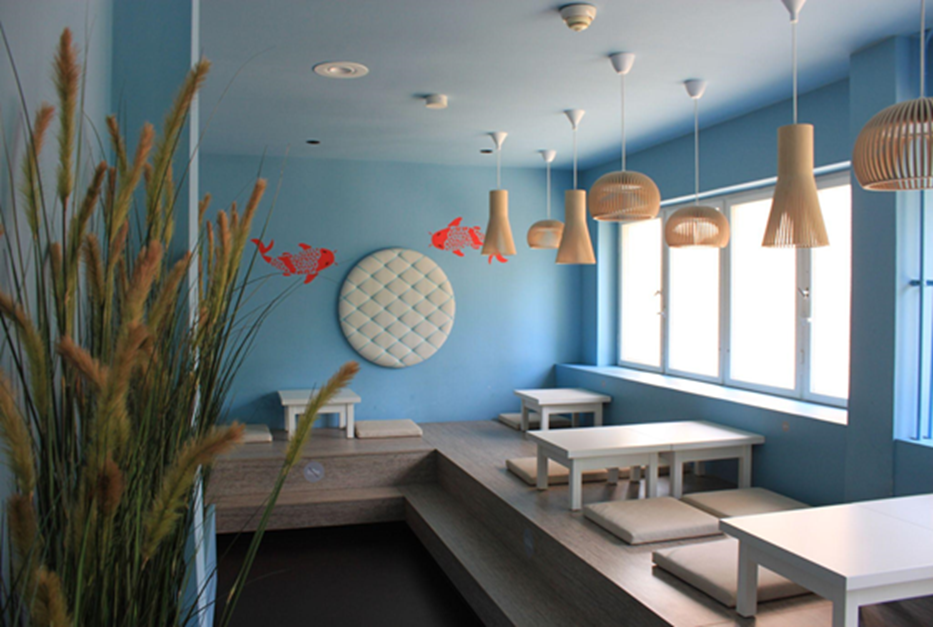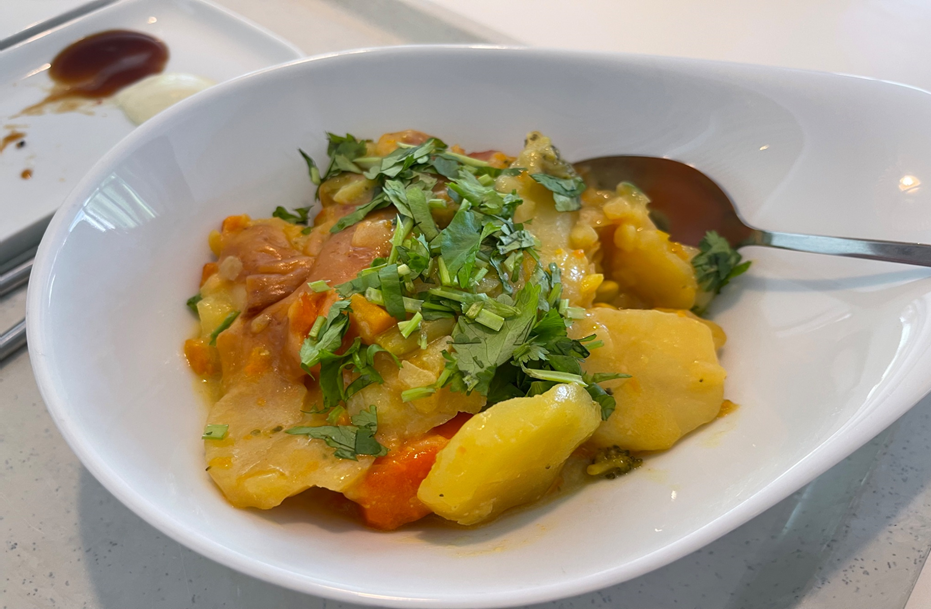by Jennifer Li and Maxime Barbasetti
As part of our methods course, we practiced participant observation by visiting the Japanese cafeteria ‘Shokudō’ at Freie Universität Berlin. In order to find out how Japanese is represented in the cafeteria, we wanted to focus our observation on the cafeteria’s interior design and the food on offer. We began our observation at the food counter. Slowly but surely, the queue at the food counter filled up, as it was lunchtime. Normally, Shokudō serves mainly vegetarian and vegan dishes, but the day we were there, they happened to have a meat ‘special’, so one of us chose spare ribs with roasted Japanese sweet potatoes and coleslaw with coriander.
Although this dish was delicious, it would not generally be described as an ‘authentic’ Japanese dish, and this was also true of the other dishes on offer. However, what all the dishes on the menu had in common was that they always included Japanese ingredients such as udon, miso or, in this case, Japanese sweet potatoes, or that the dish was inspired by Japanese classics such as Japanese curry or katsudon. Another example of this was the salad bar, which used many ingredients from Japanese and East Asian cuisine such as miso, kimchi, shiitake mushrooms, umeboshi, yuzu, sesame or seaweed in its seasonings, dressings or as garnishes. This also applies to the desserts, which are based on European recipes such as panna cotta, but have a Japanese touch. Another aspect that struck us about the dishes was that, although minimalist, they were presented or garnished in a visually appealing way. The cafeteria also features a kiosk selling Japanese treats like mochi, matcha and yuzu cheesecake which is very popular in Japan but also overseas. In summary, while there are Japanese influences in the choice of ingredients, the way of preparation as well as the dishes, the menu could be best described as Japanese-Asian-European fusion cuisine.

Copyright © Jennifer Li and Maxime Barbasetti 2024
On our way to the tatami room, which is located at the back of the cafeteria, we passed the larger dining room. Here, sudare (Japanese wooden blinds), wooden windows and lanterns, created a very cosy atmosphere with Japanese flair. The use of wood in interior design continues throughout Shokudō. In the passage that connects the main dining area with a smaller dining area and the tatami room, there are many wooden counters and seating areas. While blue is the dominant color in the main dining room, the passageway connecting the two dining rooms is painted red and, with its red pillars and lacquered stools, is reminiscent of Japanese izakaya or ramen stalls.

Copyright © Jennifer Li and Maxime Barbasetti 2024
The element that we think is most clearly associated with Japan is the painting of the sun rising behind Mount Fuji, which is hard to miss as you enter the cafeteria. Behind it is a tatami-style room that combines several elements of Japanese interior design. Although the tatami room does not have real tatami mats, the low tables and seat cushions give the impression of entering a traditional Japanese tea room. Another element is the step that leads to the tatami room itself, as it is reminiscent of a Japanese entrance area, where you place your shoes in the entrance area before entering the living room. Other decorative elements include imitation plants reminiscent of Japanese reeds, koi fish paintings on the wall and, again, wooden lanterns.

Copyright © Jennifer Li and Maxime Barbasetti 2024
However, our observation did not go unnoticed and presented us with an unexpected opportunity: While we were taking notes in the cafeteria, Esko Niggemann, responsible for Shokudō’s concept, approached us and asked what we were doing. After explaining, he offered to do an interview with us the next day. We couldn’t pass up the opportunity, so we accepted immediately. When we arrived at 9.30am the next day, we were greeted by an eerily empty canteen, with only the distant sounds of the kitchen, very different from the bustling, noisy place it usually is. There were a few staff going in and out of the kitchen, preparing for service time, but apart from them, there were just us and Mr Niggemann. We started by asking how the concept of the Japanese „Mensa“ came about. Mr Niggemann told us that the Japanese cafeteria was the brainchild of the Berlin Student Union, who wanted to integrate popular Japanese dishes such as udon, sushi and rāmen into the refectory system. As the old vegetarian cafeteria was considered obsolete due to the inclusion of vegetarian dishes in the entire system of university cafeterias in Berlin, the Studierendenwerk decided to transform it into the new Japanese cafeteria.

Copyright © Jennifer Li and Maxime Barbasetti 2024
Mr Niggemann became Shokudō’s Operations Manager. His concept for the cafeteria was shaped by his experiences as a chef in many countries, particularly in Asia. Together with a committee, he created a menu that would bring a taste of Japan to Freie Universität. The dishes had to be affordable for students, locally sourced, organic and sustainable, and mostly vegan or at least vegetarian. However, at the request of the Students‘ Union, some meat or fish dishes have been added – up to 4 times every 5 weeks. The dishes are designed under the supervision of Mr Niggemann and the other cafeteria chefs to find new ways to create Japanese dishes, using local ingredients to replace unavailable or too expensive ingredients, and vegan solutions to create a variety of Japanese fusion dishes. Some of these may be a departure from ‚authentic‘ Japanese cuisine and tradition, but they create a fun interplay of different cultures and inspirations, such as Thai curries, which inspired Mr Niggemann to create one of his dishes. At the end of the interview, we were allowed to try the maki sushi and the sauces that had been developed to accompany it, bringing the familiar tastes of wasabi and soy sauce to sushi in the cafeteria.

Copyright © Jennifer Li and Maxime Barbasetti 2024
As for the interior design, we did not get many answers because an interior design firm was commissioned to do it. However, Mr Niggemann likes the interior design and was able to explain the mysterious circular object in the tatami room that had puzzled us. It turned out to be a lamp, inspired by the moon. Mr Niggemann also told us an anecdote about the tatami room. Prior to the opening of the new cafeteria, students had the opportunity to participate in its creation by suggesting names to the committee. One of the funniest was „Barfußmensa“ – a reference to the tatami area where you’re supposed to take your shoes off. The interview gave us a lot of information that we could not have gathered by observation alone. We would like to thank Esko Niggemann for his spontaneous, open and informative interview and for his kind hospitality.
